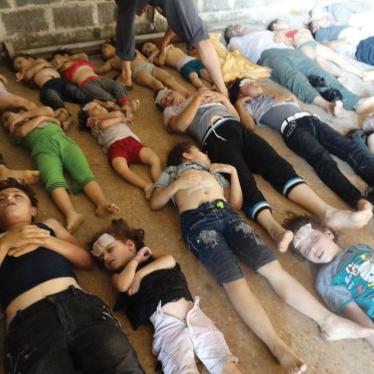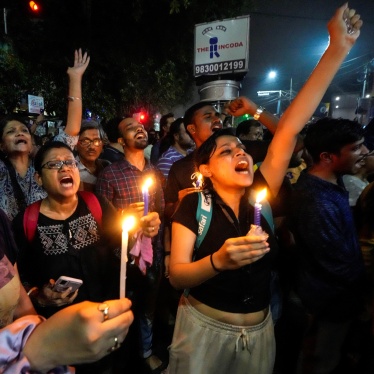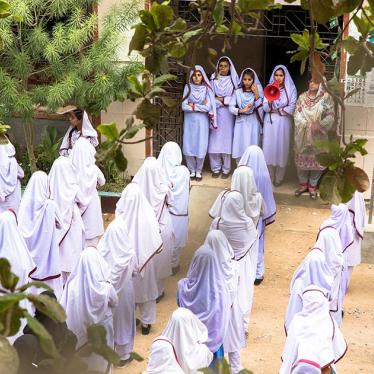(Benghazi) - Government forces are indiscriminately attacking towns in the Nafusa Mountains of western Libya almost daily, Human Rights Watch said today, after a five-day visit to the area.
The attacks with Grad rockets, an inherently indiscriminate weapon in populated areas, are threatening civilian lives, damaging civilian infrastructure, and inhibiting the return of tens of thousands of refugees from the area who have fled to Tunisia since February 2011, Human Rights Watch said. The rockets frequently land on private homes and near hospitals and mosques, forcing people to flee the area and even to live in caves.
"Grad rocket attacks are launched almost every day into residential areas with no discernible military target," said Sarah Leah Whitson, Middle East and North Africa director at Human Rights Watch. "Why would the government think there is a purpose to spraying shrapnel into people's homes, or mosques and hospitals?"
On May 1, for example, what was apparently a Grad rocket crashed into the kitchen at Omar Yughass's house in the town of Zintan, leaving cinderblock and cement strewn about the room and ruining the refrigerator and stove. Yughass, 45, his wife, and one child were sleeping in the next room and were not hurt. Yughass has since sent his family to a refugee camp in Tunis. Next door, part of the wall surrounding the house of Taher Ahmed Mansour, 62, was partly knocked down by a rocket during the same barrage.
In Zintan, the largest town in the mountain range, Human Rights Watch witnessed rocket attacks on the town center on May 22 and 23. A rocket exploded about 100 meters from Zintan Hospital on May 23, spraying shrapnel on a wall outside of a private home along a main street. Another rocket that day hit a residential street, sending shrapnel into a parked sewage disposal truck. In both cases, Human Rights Watch observed no military personnel or facilities in the vicinity.
Human Rights Watch toured two dozen sites hit by government munitions in Zintan since mid-February, when fighting began between forces loyal to Libyan leader Muammar Gaddafi and anti-government rebels in the Nafusa mountains. Human Rights Watch saw three private homes with gaping holes in their roofs, a mosque sprayed by shrapnel, a damaged school wall, destroyed cars, an olive tree upended by a Grad rocket that had lodged in its roots, and a cemetery with Grad remains scattered about. Human Rights Watch did not observe any military targets in or near any of these places.
Zintan Hospital's parking lot had two holes apparently caused by Grad rockets, and there was another hole on the street by the front gate. Doctors at the hospital said those rockets had struck on April 27.
The doctors said no civilians were wounded or killed by government-fired munitions in May, but refugees from the area in Tunisia told Human Rights Watch in early May that some government attacks had killed civilians in April.
This physical evidence confirms Human Rights Watch's previous findings, on May 9, about indiscriminate attacks in the Nafusa Mountains, based on refugee accounts collected in Tunisia.
Zintan's pre-conflict population was about 40,000, but more than 30,000 people have fled to Tunisia over the past three months, said rebel officials who control the town. Hundreds of civilians have taken shelter in nearby caves to protect themselves from government attacks.
Zintan has running water, and food is mostly brought from Tunisia. Libyan and foreign staff at the hospital provide basic care, while severely ill and wounded patients are transferred to Tunisia.
The United Nations says it has registered about 40,000 refugees who have fled the Nafusa Mountains into Tunisia. Thousands more have left and are living in private homes in Tunisia, Libyan rebel officials told Human Rights Watch.
Rocket remnants collected by rebel fighters and inspected by Human Rights Watch in Zintan resemble the steel tube casing, twisted and fragmented when it explodes, of the Grad rocket, which is fired in salvos from mobile multiple launchers. Human Rights Watch could not determine the source of the attacks but rebel commanders said that pro-Gaddafi forces were based 10 kilometers north of town. Of Soviet design, the Grad has a range of four to forty kilometers. It has no guidance system and is therefore inherently indiscriminate when fired into civilian areas.
"The Grad rocket cannot be targeted, so shooting it into a town full of civilians, with no specific military objective, violates the laws of war," Whitson said.
Human Rights Watch did observe what appeared to be military targets in Zintan, such as the military council headquarters, one anti-aircraft gun being repaired, and makeshift barracks that were used to shelter fighters from other towns, none of which appeared to have been hit. While government forces can lawfully target military objects, Human Rights Watch said, firing unguided Grad rockets into a town with civilians violates the laws-of-war obligation to distinguish between civilians and combatants.
At the same time, rebel forces in Libya are obliged to avoid as much as possible locating military objectives in densely populated areas and should endeavor to remove civilians from the vicinity of military objectives, Human Rights Watch said.
In a rolling western suburb of Zintan, Muftah Mustafa Milad, 47, has moved his wife and six children into an old cave for their protection since February.
"The caves have returned to be popular," Milad told Human Rights Watch. "If someone is outside when rockets come, they run for the cave, not the house."
He said five families, totaling 29 people, share three caves beneath a row of houses. The families have extended wires from one of the houses for electricity.
Ali Abdul Beha, 41, lives with his wife, father, and five children in a cave next to his brick house. "This place is maybe 100 years old," he said, showing how he had rigged up a satellite dish outside the cave and linked it to a television inside.
The last rocket attack in the neighborhood was on May 6, Beha said, when five rockets hit a hillside about 200 meters from the caves. Beha told Human Rights Watch that one struck about 25 meters from his elderly father as he was returning to the cave from prayers, causing his father to lose his hearing.
About a mile from central Zintan, the wisdom of using a cave as shelter was evident in a two-block area. Rockets struck Abd al-Salem Nagas's house on April 27 at night, crashed through the roof of his garage, and ripped into his car parked inside. Another rocket landed in front of a wall around his garden. Nagas, 39, said he was sleeping inside at the time, but was unhurt. His pregnant wife and two children were in a friend's cave at the time.
"I've sent the family to Tunisia," he said. "Even in a cave, I can't keep them here."
Refugees in Tunisia describe similar attacks on other towns in Nafusa. Yusif, who declined to provide his full name, said he left Nalut, a town near the Tunisian border, on May 14 after what he called a shell landed near his one-story house and broke several windows.
"I can't take my family back until I know this has stopped," said Youssef, a father of four.
Ahmed Badidi, 45, who visited his home in Nalut on May 20, said a rocket exploded on his street the day before, knocking down part of a wall. Government forces have also fired rockets into a mountain pass leading from Libya into Tunisia, most recently on May 14 and 17, when some landed near the Tunisian border town of Dehiba.
"I go home to see if my house is okay," Badidi said. "My wife says I shouldn't and maybe she is right."
Zintan Background
Zintan and much of the Nafusa range is populated by Berbers, a non-Arab ethnic group that has long felt marginalized in Libya. Anti-Gaddafi demonstrations broke out in Zintan on February 16, a day after protests began in Benghazi, in eastern Libya, over the arrest of a human rights activist. Zintan "declared war on the dictator" on February 17, a rebel official who identified himself as Colonel Abdullah told Human Rights Watch.
The rebels raided the nearby town of Garaya on February 20 and looted ammunition from government compounds. Gaddafi forces counterattacked Zintan on Febuary 28, but rebel forces, some armed with 1930's era Italian rifles, repelled the assault and captured equipment, including anti-aircraft guns used by government forces.
On March 16 government forces began an offensive from the south of Zintan. Government troops reached Zintan on the night of March 19, but rebels forced them out in an urban battle that lasted three days.
During April Gaddafi's forces were unable to re-enter Zintan, but surrounded it on the north, east, and south. Residents fled to Tunisia, especially during shelling and rocket attacks at the end of April and in early May. On May 7 rebels repelled a government attack that killed their military commander, Mohammed al-Madani.
The rebels appear unable to mount a counter-offensive against Gaddafi's forces to the north, east, or south and drive them out of Grad rocket range. On May 11 rebels tried to destroy a road that leads from the mountain town of Ryayna to the north and down to desert plains, where Gaddafi forces are based and move freely. The effort failed, and 11 rebels died. The rebel effort is complicated by the alliance of several towns in the north and east that are tied to Gaddafi by tribal loyalty and oppose the revolt.
On May 19 government forces garrisoned in the pro-Gaddafi town of Zawit Bagoul attacked Ryayna and drove rebel forces into Zintan. The maneuver brought government forces to within 10 miles of Zintan and raised fears that pro-Gaddafi forces would try to invade the town from the north. Concerns that government forces in Ryayna were preparing a May 22 assault on Zintan created a day of panic with several carloads of refugees leaving the city for the east. As of May 26, no government ground attack on Zintan had taken place.





